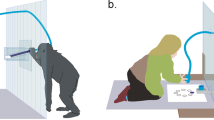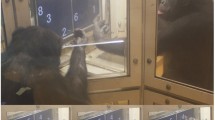Abstract
Group-living animals frequently face situations in which they must coordinate individual and sometimes conflicting goals. We assessed chimpanzees’ ability to coordinate in a Stag Hunt game. Dyads were confronted with a situation in which each individual was already foraging on a low-value food (hare) when a high-value food (stag) appeared that required collaboration for retrieval, with a solo attempt to get the stag resulting in a loss of both options. In one condition visibility between partners was open whereas in the other it was blocked by a barrier. Regardless of condition, dyads almost always (91%) coordinated to choose the higher valued collaborative option. Intentional communication or monitoring of the partner’s behavior before decision making—characteristic of much human coordination—were limited. Instead, all dyads adopted a leader–follower strategy in which one partner took the risk of going first, presumably predicting that this would induce the other to join in (sometimes communicating if she was slow to do so). These results show that humans’ closest primate relatives do not use complex communication to coordinate but most often use a less cognitively complex strategy that achieves the same end.




Similar content being viewed by others
Notes
The precise reward structure is not our main concern here. But in chimpanzee group hunting each individual knows that he has a chance of capturing the monkey himself, in which case he will get a very high reward. He also knows that if someone else captures the monkey he will still get some meat by begging and harassing the captor afterwards. Moreover, even a scrap of meat is worth considerable effort as it supplies many micronutrients not available in vegetation (Tennie et al. 2009).
References
Alvard, M. (in press). Human social ecology. In J. Mitani (Ed.), The evolution of primate societies. Chicago: University of Chicago Press.
Alvard, M., & Nolin, D. (2002). Rousseau’s whale hunt? Coordination among big game hunters. Current Anthropology, 43(4), 533–559.
Bearden, J. (2001). The evolution of inefficiency in a simulated stag hunt. Behavior Research Methods, Instruments, & Computers, 33(2), 124–129.
Boesch, C., & Boesch-Achermann, H. (2000). The chimpanzees of the Taï Forest: Behavioural ecology and evolution. Oxford: Oxford University Press.
Brinck, I., & Gärdenfors, P. (2003). Co-operation and communication in apes and humans. Mind & Language, 18(5), 484–501.
Conradt, L., & Roper, T. J. (2005). Consensus decision making in animals. Trends in Ecology & Evolution, 20(8), 449–456.
Conradt, L., & Roper, T. J. (2009). Conflicts of interest and the evolution of decision sharing. Philosophical Transactions of the Royal Society B: Biological Sciences, 364, 807–819.
Cooper, R., DeJong, D., Forsythe, R., & Ross, T. (1994). Alternative institutions for resolving coordination problems: Experimental evidence on forward induction and preplay communication. In J. Friedman (Ed.), Problems of coordination in economic activity. Dordrecht: Kluwer Academic.
Crawford, M. P. (1937). The cooperative solving of problems by young chimpanzees. Comparative Psychology Monographs, 14, 1–88.
Crawford, V. (1998). A survey of experiments on communication via cheap talk. Journal of Economic Theory, 78, 286–298.
Fang, C., Kimbrough, S. O., Valluri, A., Zheng, Z., & Pace, S. (2002). On adaptive emergence of trust behavior in the game of stag hunt. Group Decision and Negotiation, 11(6), 449–467.
Fischer, J., & Zinner, D. (2011). Communication and cognition in primate group movement. International Journal of Primatology. doi:10.1007/s10764-011-9542-7
Gilby, I. C., & Wrangham, R. W. (2007). Risk-prone hunting by chimpanzees (Pan troglodytes schweinfurthii) increases during periods of high diet quality. Behavioral Ecology and Sociobiology, 61, 1771–1779.
Gilby, I. C., Eberly, L. E., & Wrangham, R. W. (2008). Economic profitability of social predation among wild chimpanzees: Individual variation promotes cooperation. Animal Behaviour, 75(2), 351–360.
Greenberg, J. R., Hamann, K., Warneken, F., & Tomasello, M. (2010). Chimpanzee helping in collaborative and non-collaborative contexts. Animal Behaviour, 80, 873–880.
Hare, B., Call, J., Agnetta, B., & Tomasello, M. (2000). Chimpanzees know what conspecifics do and do not see. Animal Behaviour, 59(4), 771–785.
Hare, B., Call, J., & Tomasello, M. (2001). Do chimpanzees know what conspecifics know? Animal Behaviour, 61(1), 139–151.
Heilbronner, S. R., Rosati, A. G., Stevens, J. R., Hare, B., & Hauser, M. D. (2008). A fruit in the hand or two in the bush? Divergent risk preferences in chimpanzees and bonobos. Biology Letters, 4, 246–249.
Hirata, S., & Fuwa, K. (2007). Chimpanzees (Pan troglodytes) learn to act with other individuals in a cooperative task. Primates, 48(1), 13–21.
Hockings, K. J., Anderson, J. R., & Matsuzawa, T. (2006). Road crossing in chimpanzees: A risky business. Current Biology, 16(17), R668–R670.
Jensen, K., Call, J., & Tomasello, M. (2007). Chimpanzees are rational maximizers in an ultimatum game. Science, 318, 107–109.
King, A. J., Johnson, D. D. P., & van Vugt, M. (2009). The origins and evolution of leadership. Current Biology, 19, R911–R916.
Kummer, H. (1968). Social organization of hamadryas baboons: A field study. Basel: Karger.
Liebal, K., Pika, S., & Tomasello, M. (2004). Social communication in siamangs (Symphalangus syndactylus): Use of gestures and facial expressions. Primates, 45(1), 41–57.
Melis, A. P., Hare, B., & Tomasello, M. (2006a). Chimpanzees recruit the best collaborators. Science, 311(5765), 1297–1300.
Melis, A. P., Hare, B., & Tomasello, M. (2006b). Engineering cooperation in chimpanzees: Tolerance constraints on cooperation. Animal Behaviour, 72(2), 275–286.
Melis, A. P., Call, J., & Tomasello, M. (2006). Chimpanzees (Pan troglodytes) conceal visual and auditory information from others. Journal of Comparative Psychology, 120, 154–162.
Melis, A. P., Hare, B., & Tomasello, M. (2009). Chimpanzees coordinate in a negotiation game. Evolution and Human Behavior, 30, 381–392.
Meunier, H., Deneubourg, J. L., & Petit, O. (2008). How many for dinner? Recruitment and monitoring by glances in capuchins. Primates, 49, 26–31.
Mitani, J. C., & Watts, D. P. (1999). Demographic influences on the hunting behavior of chimpanzees. American Journal of Physical Anthropology, 109(4), 439–454.
Nunn, C. L., & Lewis, R. J. (2001). Cooperation and collective action in animal behavior. In R. Noë, J. A. R. A. M. van Hooff, & P. Hammerstein (Eds.), Economics in nature. Cambridge: Cambridge University Press.
Petit, O., & Bon, R. (2010). Decision-making processes: The case of collective movements. Behavioural Processes, 84, 635–647.
Pillot, M.-H., & Deneubourg, J.-L. (2010). Collective movements, initiation and stops: Diversity of situations and law of parsimony. Behavioural Processes, 84, 657–661.
Povinelli, D. J., & O’Neill, D. K. (2000). Do chimpanzees use their gestures to instruct each other? In S. Baron-Cohen, H. Tager-Flusberg, & D. J. Cohen (Eds.), Understanding other minds: Perspectives from autism. New York: Oxford University Press.
Pyritz, L., Kappeler, P. M., & Fichtel, C. (2011). Coordination of group movements in wild red-fronted lemurs (Eulemur rufifrons): Processes and influence of ecological and reproductive seasonality. International Journal of Primatology.
Rands, S. A., Cowlishaw, G., Pettifor, R. A., Rowcliffe, J. M., & Johnstone, R. A. (2003). Spontaneous emergence of leaders and followers in foraging pairs. Nature, 423, 432–434.
Skyrms, B. (2002). Signals, evolution and the explanatory power of transient information. Philosophy of Science, 69(3), 407–428.
Skyrms, B. (2004). The stag hunt and the evolution of social structure. New York: Cambridge University Press.
Sueur, C., & Deneubourg, J. L. (2011). Self-Organization in Primates: Understanding the Rules Underlying Collective Movements. International Journal of Primatology. doi:10.1007/s10764-011-9520-0
Sueur, C., & Petit, O. (2009). Signals use by leaders in Macaca tonkeana and Macaca mulatta: Group-mate recruitment and behaviour monitoring. Animal Cognition, 13(2), 239–248.
Tennie, C., Gilby, I. C., & Mundry, R. (2009). The meat-scrap hypothesis: Small quantities of meat may promote cooperative hunting in wild chimpanzees (Pan troglodytes). Behavioral Ecology and Sociobiology, 63(3), 421–431.
Tomasello, M. (1995). Joint attention as social cognition. In C. Moore & P. J. Dunham (Eds.), Joint attention: Its origins and role in development. Hillsdale: Lawrence Erlbaum Associates.
Tomasello, M. (2009). Why we cooperate. Cambridge: MIT Press.
Tomasello, M., & Carpenter, M. (2007). Shared intentionality. Developmental Science, 10(1), 121–125.
Van Vugt, M. (2006). Evolutionary origins of leadership and followership. Personality and Social Psychology Review, 10(4), 354–371.
Watts, D. P., & Mitani, J. C. (2002). Hunting behavior of chimpanzees at Ngogo, Kibale National Park, Uganda. International Journal of Primatology, 23(1), 1–28.
Acknowledgments
We thank Dr. Joanna Setchell and the International Journal of Primatology (IJP) for the generous fund from Springer–IJP that made this special issue possible. We thank Josefine Kalbitz and Hanna Petschauer from the Max Planck Institute for Evolutionary Anthropology for assistance in study preparation and Raik Pieszek for technical support, as well as Roger Mundry for statistical advice. In particular, we appreciate the hard work of the Wolfgang-Köhler-Primate-Research-Center animal caretakers, mainly Daniel Geissler and Stefan Leideritz. We also thank Lisa Klepfer, Katja Karg, Franziska Schleger, Nadja Miosga, Maria Baumeister, Nele Zickert, Carolin Kade, Mandy Rogalla, Christian Nawroth, Sina Mackay, Caroline Mayer, Christina Meier, Franka Köpp and Julia Löpelt for help with our tests, along with Claudia Menzel for the reliability coding. We thank Julia Greenberg, Anna-Claire Schneider, and Katharina Hamann for fruitful discussions throughout the study and the reviewers and editors for the very helpful comments on the manuscript. The research of A. F. Bullinger is supported by a grant from the German National Academic Foundation.
Author information
Authors and Affiliations
Corresponding author
Electronic supplementary material
Below is the link to the electronic supplementary material.
ESM 1
(DOC 29 kb)
Rights and permissions
About this article
Cite this article
Bullinger, A.F., Wyman, E., Melis, A.P. et al. Coordination of Chimpanzees (Pan troglodytes) in a Stag Hunt Game. Int J Primatol 32, 1296–1310 (2011). https://doi.org/10.1007/s10764-011-9546-3
Received:
Accepted:
Published:
Issue Date:
DOI: https://doi.org/10.1007/s10764-011-9546-3




